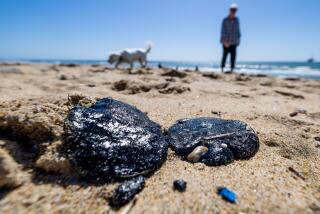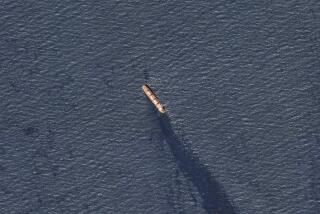Saudis Sharply Cut Estimates of 2 Oil Slicks
- Share via
DHAHRAN, Saudi Arabia — Saudi officials are dramatically reducing their estimates of the size of two giant oil slicks in the Persian Gulf, saying it now appears likely that 3 million barrels or less has been dumped from oil facilities and tankers off the coast of Kuwait.
Although authorities initially announced that the spills could reach 11 million barrels--the largest in history--a U.S. Coast Guard spokesman said Wednesday that the Saudi Meteorology and Environmental Protection Agency now believes the slicks range from 500,000 barrels to 3 million barrels. In Alaska, 254,762 barrels spilled during the Exxon Valdez accident in Prince William Sound.
Also, it appears that a third spill, near the Mina al Bakr oil terminal in southern Iraq, is leaking about 1,000 barrels a day, a rate that raises hope that the widening slick can be controlled before wreaking environmental devastation throughout the Persian Gulf.
Meanwhile, officials in the Saudi Ministry of Petroleum and Mineral Resources said large dark clouds of smoke are moving toward Saudi Arabia from an estimated 40 to 50 oil-well fires allegedly triggered by Iraqi forces in Kuwait.
U.S. military briefers in the Saudi capital of Riyadh said at least five additional wells have been torched in the southern Kuwaiti oil field of Wafra over the last week.
“We believe this is an integral part of the Iraqi war-fighting strategy, whereby they’re periodically lighting off wells to cloud the battlefield and mask their movements,” said Marine Brig. Gen. Richard I. Neal.
A petroleum ministry spokesman said the smoke cloud is moving steadily south. “It is right now in Kuwait and over the Gulf,” he said.
Officials cautioned that the new oil spill estimates are tentative and are based on flights over the Saudi coast that did not venture over the waters off Kuwait or Iraq.
Satellite photos show a potentially much more alarming picture, with unidentified darkened areas covering as much as a third of the northern Persian Gulf, a Saudi official said. However, some Saudi scientists have said they believe that the darkened areas are not oil, but perhaps coral reefs, algae or patches of sea grass.
“At this point, we are talking actually about a range somewhere between 3 (million) and 10 (million barrels),” said Abdullah E. Dabbagh, head of a research institute in Dhahran plotting the course of the spill. “I think 3 (million) is probably a fairly reasonable number.”
Saudi officials said their original estimates of the size of the slick were based on the amount of oil believed to be in the leaking tankers, plus the quantity that could have been pumped through the pipeline at Mina al Bakr during the time the taps were flowing.
New estimates are based on the actual flow of the spill into Saudi Arabia and the guesswork available through limited overflights. The estimates remain very inexact, however, because so much of the spill remains hidden from view in Kuwaiti waters. Scientists have been unable, for example, to measure the depth of most of the spill.
The lower estimates are receiving support from other experts.
The Oil Spill Intelligence Report, a weekly newsletter based in Arlington, Mass., points out that other factors might contribute to an even greater reduction.
Because the oil is a light crude, about 40% probably evaporated within a couple of days, according to Dagmar Etkin, research editor of the spill report. She said the oil that evaporated would have been the most toxic, the most flammable and the most soluble.
At most, 24 million gallons or 571,420 barrels remained in the water several days after the spill, she said.
The organization bases its figures on eyewitness accounts from scientists who have flown over the spill and from government estimates of the size of the slick.
For example, news reports several days after the spill described a 350-square-mile slick. Etkin said a slick that size could have contained no more than 571,420 barrels.
“It could even be less than 24 million gallons considering you don’t have complete coverage of the water,” Etkin said.
Most of the oil reaching Saudi Arabia appears to be Kuwaiti oil, Saudi officials said, indicating that it probably came from the Al Ahmadi terminal in central Kuwait, where Iraqi officials are believed to have dumped millions of barrels of oil into the sea before an allied bombing run destroyed pumping facilities at the terminal.
More oil is believed to be flowing from five tankers loaded with Iraqi crude that had been parked in Kuwait Harbor farther north.
A Saudi petroleum ministry official said the largest part of the spill has moved south only as far as the Kuwait-Saudi border, but U.S. Coast Guard and other Saudi officials say Kuwaiti oil has washed up as far south into Saudi Arabia as Ras al Zawr, about 25 miles north of the giant petrochemical city of Jubayl.
At least 350 kilometers (215 miles) of the Saudi coastline have been exposed to the spill so far, although it has reached shore only in a few areas, primarily in the Safaniya region. A diplomatic source said oil there is a foot thick along the beach in some places, and six inches thick in the water.
Large rubber booms have been installed around industrial facilities along the Saudi coast, primarily at Jubayl, where Saudi officials expect to spend $1 billion over the next six months to protect the coastline, which houses the world’s largest water desalination plant.
Even if the lower spill estimates prove true, Saudi officials say the spills nonetheless pose the threat of environmental devastation in the fragile Gulf.
John C. Walsh, assistant director general of the Boston-based World Society for the Protection of Animals, told reporters that thousands of shore birds have died already.
Times staff writer Maura Dolan contributed to this article.
More to Read
Sign up for Essential California
The most important California stories and recommendations in your inbox every morning.
You may occasionally receive promotional content from the Los Angeles Times.













